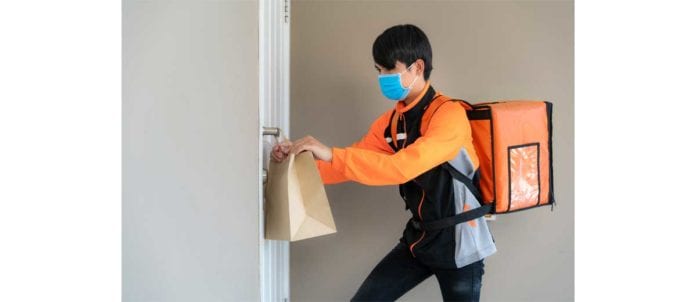The Challenge
In order to ensure consumer confidence and continued trust, companies offering food delivery — both in-house and third-party — were forced to scramble to define protocols and implement the digital infrastructure to enable effective contactless delivery to meet the demand brought on by the sudden onset of the pandemic.
The fact that this was essentially a new service only added to the challenge restaurants faced when navigating how to implement it. Ordering systems now had to facilitate pre-payment and collection of drop-off instructions; restaurant staff and delivery drivers had to be trained on new procedures; and many operators sourced solutions for tamper-evident packaging.
“We’re privileged to be able to provide service to our customers, but having to incorporate new zero-contact procedures — whether it’s delivery or carry out — [required] a lot of work,” shares Jeff Kacmarek, VP Marketing and Product Development, Domino’s Pizza of Canada. “A lot of changes have taken place in our operations as a result.”
Restaurants had to update their digital-ordering platforms, which let to brands such as Swiss Chalet releasing updated mobile apps featuring integration with new contactless-delivery and curbside-pickup options.
And, once everything was in place, significant effort had to be put into communicating the new offering and educating customers on the new procedures. Depending on the contactless-delivery procedures employed, communicating with customers through the delivery process has also become increasingly important.
In an open letter released during the early days of the pandemic, Restaurant Brands International CEO Jose Cil highlighted the significant work a company of its scale had to undertake to quickly respond to these needs. “Our in-house digital team has done great work to rapidly expand and enhance our online-ordering platforms for all three brands,” he explained. “At the same time, our marketing teams have quickly pivoted to re-direct our substantial marketing efforts to focus on the importance and safety of our mobile app, delivery and drive-thru channels, in addition to other major health-and-safety measures like contactless payments.”
Using tech to communicate health and safety is of great importance, Manoj Jasra, Chief Marketing & Digital Officer, Northland Properties, stressed during the Canadian Restaurant Investment & Leadership Summit in November, highlighting pre-order communication on this front as a key element operators need to be “really great at.” This, he explained, is because, in the future, attracting customers will come down to providing “what gives consumers the most confidence, more than anything.”
“As the second wave of the pandemic intensifies, complying with stringent safety protocols is the only way for businesses to remain open and for our consumers to have peace of mind when using services such as food delivery,” says Di Han, general manager of Facedrive Foods.
The Opportunity
While significant effort was required to get contactless-delivery offerings off the ground, the opportunity they provided to build trust and loyalty through these challenged times will serve operators well going forward.
“Letting our guests behind the curtain has always been counterintuitive, but…being transparent with respect to what steps and measures you’re taking [is important] and guests are willing to meet you halfway if you make those steps on that [front],” Royal Nasager, VP Marketing, St. Louis Franchise Ltd., shared during the Canadian Restaurant Investment & Leadership Summit.
And, those who have invested on this front are expected to see continued benefits beyond the short term. “I really believe there’s going to be a collective [pandemic] PTSD or hangover,” says Nasager. “Even when there is a ‘cure’ or vaccine, consumer consumption habits [and] how they want to engage and interact and brands will not change that much.”
Having to adopt new tech and procedures to survive the pandemic could also shift the historically slow-to-adapt foodservice industry, collectively, into a more agile sector. A Panasonic Corporation of North America survey (August 2020), reveals businesses within the industry now see an urgent need to rapidly adapt to changing customer behaviour and demands. One in four foodservice operations and food retailers now view their companies as tech-forward early adopters — up from one in eight prior to the pandemic.
“Agility has become essential to business success and digital-technology adoption the major enabler. The urgency to advance health and safety and consumer convenience is fast-tracking innovation to organizational business models in the industry,” says Lauren Sallata, Chief Marketing Officer, Panasonic Corporation of North America.
As time goes on, there is also a growing roster of tools to help restaurants more easily facilitate and streamline contactless delivery. For example, Lightspeed launched Order Ahead in September, an online-ordering management system that allows for seamless integration of ordering platforms with Lightspeed POS and the ability to provide real-time status updates to customers. In December, DoorDash also introduced DoorDash Self-Delivery, which allows operators to handle delivery in-house while appearing on the DoorDash marketplace.
And, as Jasra points out, the future of foodservice will likely focus on providing “a variety of different types of experiences,” rather than relying so heavily on on-premise visits.


















